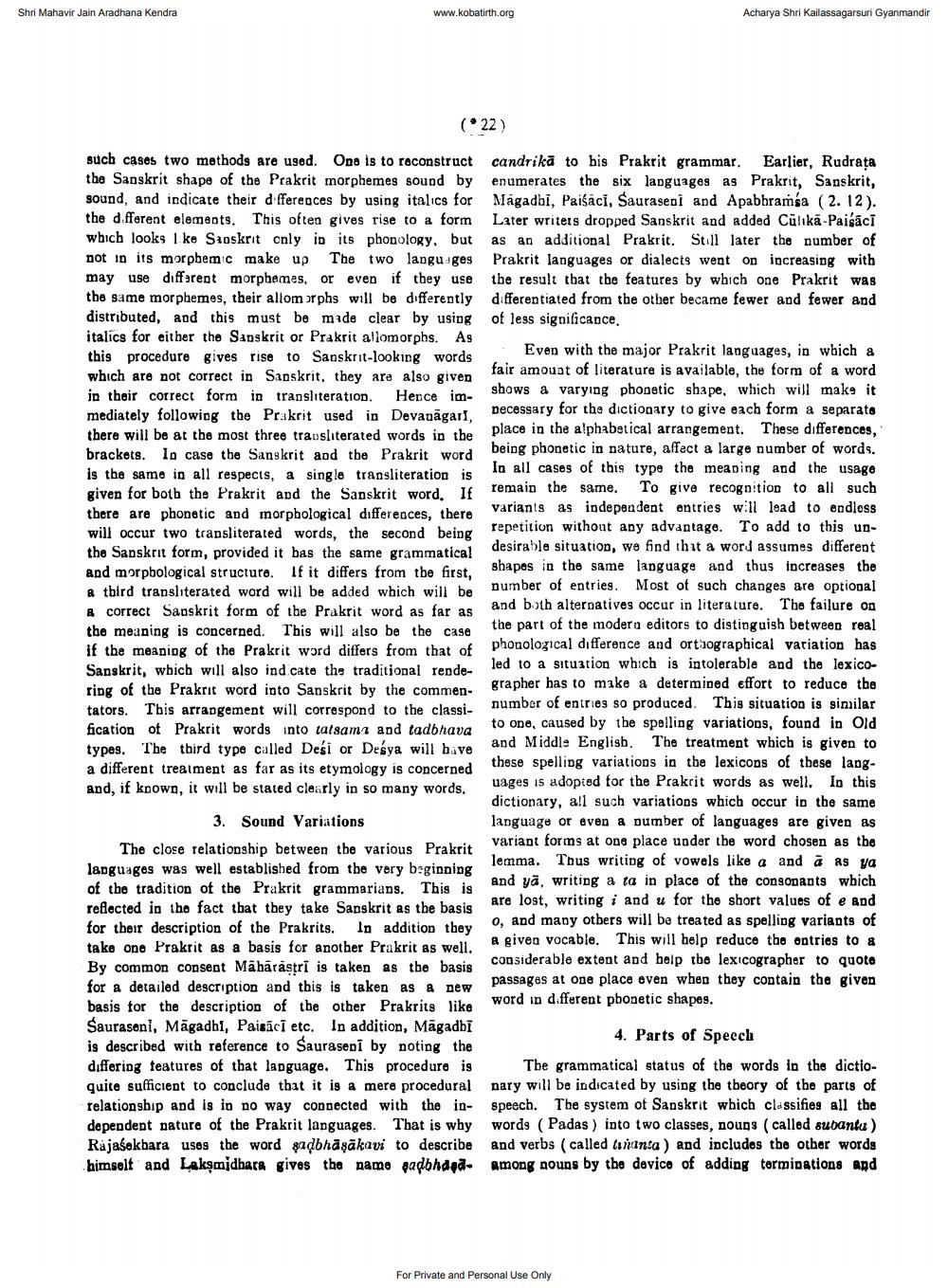________________
Shri Mahavir Jain Aradhana Kendra
www.kobatirth.org
(22)
such cases two methods are used. One is to reconstruct the Sanskrit shape of the Prakrit morphemes sound by sound, and indicate their differences by using italics for the different elements. This often gives rise to a form which looks like Sanskrit only in its phonology, but not in its morphemic make up The two languages may use different morphemes, or even if they use the same morphemes, their allomorphs will be differently distributed, and this must be made clear by using italics for either the Sanskrit or Prakrit allomorphs. As this procedure gives rise to Sanskrit-looking words which are not correct in Sanskrit, they are also given in their correct form in transliteration. Hence immediately following the Prakrit used in Devanagari, there will be at the most three transliterated words in the brackets. In case the Sanskrit and the Prakrit word is the same in all respects, a single transliteration is given for both the Prakrit and the Sanskrit word. If there are phonetic and morphological differences, there will occur two transliterated words, the second being the Sanskrit form, provided it has the same grammatical and morphological structure. If it differs from the first, a third transliterated word will be added which will be a correct Sanskrit form of the Prakrit word as far as the meaning is concerned. This will also be the case if the meaning of the Prakrit word differs from that of Sanskrit, which will also indicate the traditional rendering of the Prakrit word into Sanskrit by the commentators. This arrangement will correspond to the classification of Prakrit words into tatsama and tadbhava types. The third type called Desi or Deśya will have a different treatment as far as its etymology is concerned and, if known, it will be stated clearly in so many words. 3. Sound Variations
The close relationship between the various Prakrit languages was well established from the very beginning of the tradition of the Prakrit grammarians. This is reflected in the fact that they take Sanskrit as the basis for their description of the Prakrits. In addition they take one Prakrit as a basis for another Prakrit as well. By common consent Mähäräṣṭrī is taken as the basis for a detailed description and this is taken as a new basis for the description of the other Prakrits like Sauraseni, Magadhi, Paisacī etc. In addition, Magadbī is described with reference to Sauraseni by noting the differing features of that language. This procedure is quite sufficient to conclude that it is a mere procedural relationship and is in no way connected with the independent nature of the Prakrit languages. That is why Rajasekhara uses the word adbhāṣākavi to describe himself and Lakṣmidhara gives the name sadbhdaa
Acharya Shri Kailassagarsuri Gyanmandir
candrika to his Prakrit grammar. Earlier, Rudrata enumerates the six languages as Prakrit, Sanskrit, Magadhi, Paiśācī, Šauraseni and Apabhramśa (2. 12). Later writers dropped Sanskrit and added Culika-Paiśācī as an additional Prakrit. Still later the number of Prakrit languages or dialects went on increasing with the result that the features by which one Prakrit was differentiated from the other became fewer and fewer and of less significance.
Even with the major Prakrit languages, in which a fair amount of literature is available, the form of a word shows a varying phonetic shape, which will make it necessary for the dictionary to give each form a separate place in the alphabetical arrangement. These differences, being phonetic in nature, affect a large number of words. In all cases of this type the meaning and the usage remain the same. To give recognition to all such variants as independent entries will lead to endless repetition without any advantage. To add to this undesirable situation, we find that a word assumes different shapes in the same language and thus increases the number of entries. Most of such changes are optional and both alternatives occur in literature. The failure on the part of the modern editors to distinguish between real phonological difference and orthographical variation has led to a situation which is intolerable and the lexicographer has to make a determined effort to reduce the number of entries so produced. This situation is similar to one, caused by the spelling variations, found in Old and Middle English. The treatment which is given to these spelling variations in the lexicons of these languages is adopted for the Prakrit words as well. In this dictionary, all such variations which occur in the same language or even a number of languages are given as variant forms at one place under the word chosen as the lemma. Thus writing of vowels like a and a as ya and ya, writing a ta in place of the consonants which are lost, writing i and u for the short values of e and o, and many others will be treated as spelling variants of a given vocable. This will help reduce the entries to a considerable extent and help the lexicographer to quote passages at one place even when they contain the given word in different phonetic shapes.
4. Parts of Speech
The grammatical status of the words in the dictionary will be indicated by using the theory of the parts of speech. The system of Sanskrit which classifies all the words (Padas) into two classes, nouns (called subantu) and verbs (called tinanta) and includes the other words among nouns by the device of adding terminations and
For Private and Personal Use Only




